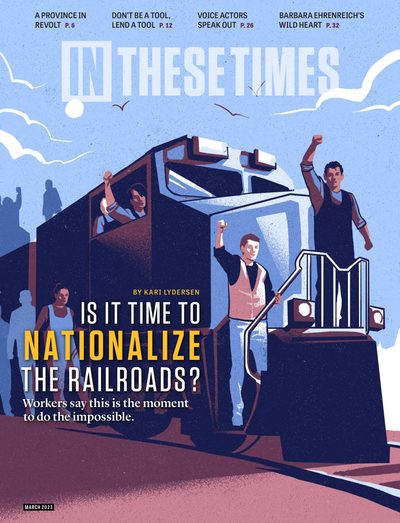The Case for Nationalizing the Railroads
Workers say now is the time to do the impossible.
Kari Lydersen
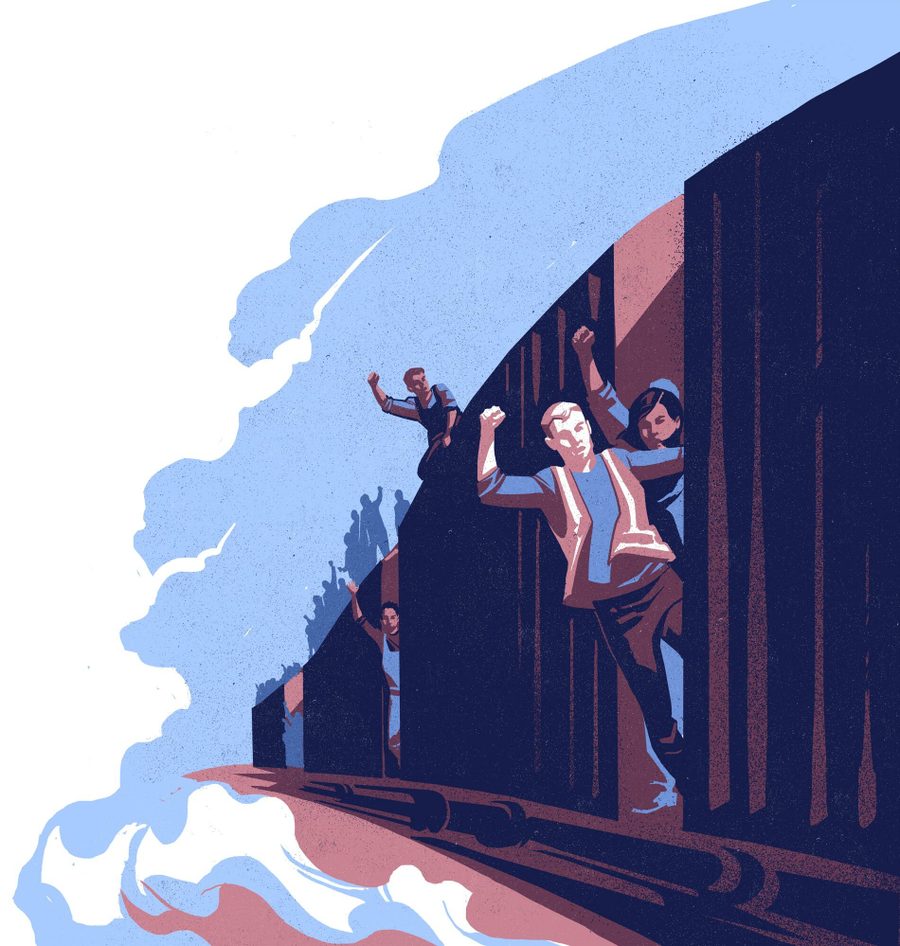
Railroad workers packed themselves into hotel conference rooms near Chicago’s O’Hare International Airport in June 2022 to talk fervently about a momentous event potentially on the horizon: the first industry-wide rail strike in three decades.
“All 12 railroad unions have proclaimed themselves united,” said Ron Kaminkow, Railroad Workers United (RWU) general secretary, during a conference session about chokepoints in the supply chain. “There could actually be a national railroad strike for the first time in almost 30 years.”
Contract negotiations between those 12 unions and the country’s major freight railroad companies had ground to a halt by the conference, which was organized by RWU and the pro-union group Labor Notes.
In July, 99.5% of the membership of the union representing railroad engineers — the Brotherhood of Locomotive Engineers and Trainmen — voted to authorize a strike if legal hurdles were cleared.
The possibility presented a challenge for the Biden administration. President Joe Biden had become known as the most labor-friendly president in recent history, while a walkout threatened to paralyze the economy with a potential cost of $2 billion per day. The administration eventually negotiated a deal with union leaders and company leaders, announced Sept. 15, 2022, requiring a significant pay raise for workers without meaningfully addressing their primary concerns: short-staffing and a lack of paid sick days.
Many elected officials and pundits lauded the deal, but it still needed to be ratified by each union’s rank and file.
Three unions representing railroad workers voted down the proposed contract, while others voted for it. Then, in November, the country’s largest rail union — the SMART Transportation Division, which represents conductors and brakemen — rejected the deal, and a national rail strike was firmly on the table. Even unions that approved of the deal pledged to honor any picket lines.
On December 1, 2022, at Biden’s urging, Congress intervened, passing a law to force the unions to agree to the deal. Many railroad workers were furious — and felt betrayed.
“It was very frustrating, from the ‘most pro-labor president America’s ever had,’” says Matt Weaver, legislative director for the Brotherhood of Maintenance of Way Employees, the nation’s third-largest railroad union. “When [railroads] have record profits and profit margins, and yet this deal is imposed, we’ve seen that our labor is expendable.”
The ordeal has also led many railroad workers and industry watchers to consider a vastly increased role for government in freight railroads: nationalization.
On Oct. 5, 2022, RWU adopted a resolution calling for public ownership of railroad infrastructure, which is operated for the public benefit. The grassroots organization brings together members from all 12 rail unions but has no official power to negotiate with employers or the government. Its members were prominently featured in national media around the possible strike, and the group says its resolution reflects a growing demand for change among railroad workers. The resolution outlines how the rail industry has downsized one-third of its workforce, “outraged shippers” by “jacking up prices,” “failed to solicit nor accept new but ‘less profitable’ freight,” opposed safety measures and took a “hostile stance” toward unions, among other failings.
Meanwhile, the United Electrical, Radio and Machine Workers of America (UE) recently also issued a strident call for public ownership of railroads to protect the economy, workers, frontline communities and the environment.
“We demand that Congress immediately begin a process of bringing our nation’s railroads under public ownership,” reads the statement from the UE general executive board. The union, which represents electrical workers and other sectors, argues that the major railroad companies — like electric utilities — are “natural monopolies,” and have an “endless thirst for profit.”
The union argues that nationalization is necessary both to protect workers and to fight climate change and railroad-related pollution that disproportionately impacts communities of color and low-income communities. The statement notes that in 2021, UE launched a Green Locomotive Project to promote zero-emissions electric locomotives in rail yards and cleaner diesel locomotives on the tracks. “Although the legislation our allies introduced in Congress would have provided generous financial incentives for the railroads to adopt this green technology, they opposed us every step of the way,” the statement read.
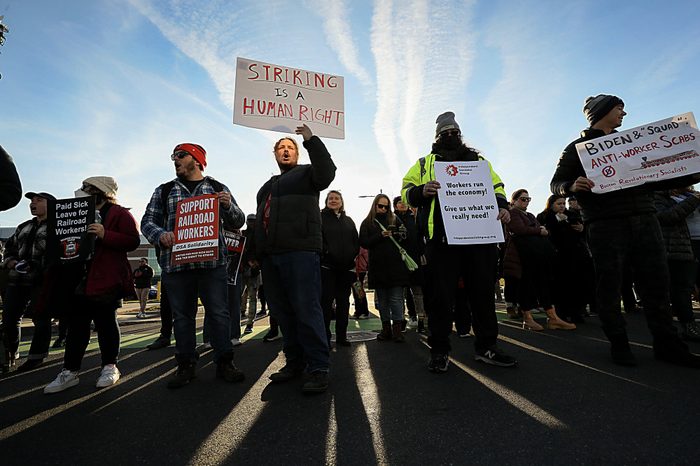
Public Equity
The threatened railroad strike underscores how much the U.S. economy depends on freight railroads. It also exposes the fragility of a system owned and run in large part by four massively profitable carrier companies that act as de facto monopolies.
BNSF and Union Pacific run the vast majority of freight west of the Mississippi River, while Norfolk Southern and CSX run most of the freight to the east.
In 2021, BNSF and Union Pacific reported record profits of $6.5 billion and $6 billion, respectively, while Norfolk Southern reported a record $4.45 billion, and CSX notched $3.8 billion. The profit is doled out to highly paid executives and shareholders with too little invested back into operations and infrastructure, as many workers and some industry experts see it. The imbalance has helped make the case for more decision-making power for railroad workers and a greater oversight role for the public. Railroad workers who support nationalization would like to see workers in direct leadership positions, and think removing the profit motive would translate to better working conditions.
“The idea of nationalizing the rails — that strikes fear into the [tenth of 1%] of billionaires who own most of the wealth in this country,” says Marilee Taylor, a recently retired BNSF locomotive engineer from Chicago. “It has to be under the control of those who actually know the railroads, which is not the suits. It’s not the CEOs. It’s those who work it.”
In April 2022, hearings were held before the federal Surface Transportation Board — the body charged with overseeing America’s rail system. Officials from major industries (including agriculture and chemicals) lamented the increasing unreliability and unaffordability of freight rail. They blamed the large carriers’ increasing reliance on “Precision Scheduled Railroading,” wherein employees and routes are slashed to the bare minimum to maximize profits. They also testified that the national supply chain crisis was caused not just by the pandemic, but by railroad understaffing, price gouging and the failure to invest in infrastructure. Union leaders and workers said the railroad companies are neglecting safety and maintenance in pursuit of more profit, with longer trains and fewer people.
Matt Hollis, a second-generation railroad worker and national vice president of the Transportation Communications Union, testified he’s seen the “complete and utter degradation of our nation’s Class I railroads over the past six to seven years.” He went on: “I’ve watched as private equity firms have acquired controlling stakes in railroads only to use their power to deploy business models that extract as much wealth as possible, to the detriment of the railroads’ workers, their customers and ultimately the public interest.”
Rank-and-file railroad workers tell In These Times they have similar experiences.
Nick Wurst, a Massachusetts-based conductor for one of the major freight railroads, says he sees firsthand how “railroads have, through corporate decision-making, put themselves in a situation where they are in perpetual crisis because they operate on the narrowest possible margins in terms of staffing and maintenance. There’s nothing there in order to try to deal with any kind of hiccups, whether that hiccup comes in the form of six feet of snow or a global pandemic. The movement of people, goods, raw materials is too important — too many people rely on it — for decision-making to be limited to profitability.
“The goal should not be making profit,” Wurst adds. “The goal should be getting everything where it needs to go as efficiently as possible.”
Hugh Sawyer, an engineer for Norfolk Southern in Georgia, was previously opposed to the idea of nationalization. “I’m a capitalist; I live in America,” he laughs. But after seeing the railroad companies shut down their less-profitable lines, slash their workforces and run workers into the ground with little resistance from union leadership, as many workers see it, he thinks change is necessary. Now, Sawyer wants regulation and “nationalization and rationalization,” with all railroad employees represented by one union, working for the federal government.
At an “investor day” in December 2022, Norfolk Southern CEO Alan Shaw acknowledged many of the problems and promised the company would no longer prioritize “operating ratios” — achieved by slashing costs to boost profits — as Wall Street investors have desired. Among other things, Shaw said, the company would keep higher staffing levels and stop furloughing workers during periodic downturns.
“When the time came to rebuild our ranks as freight transportation demand returned, we were unable to rehire quickly enough to operate fluidly,” Shaw told investors. “In the long term, these disruptions have eroded the confidence customers need to have if they are going to structurally rely on rail instead of highways.”
In These Times reached out to all four major carriers to comment on many of the claims in this article, including concerns about the use of Precision Scheduled Railroading and its effects on rail workers, and complaints about a lack of infrastructure and operations investment while profits soar. The companies deferred to the Association of American Railroads, an industry group, which said in a statement that “each year, the privately-owned freight rail industry reinvests about $20 billion in maintenance and capital improvements that enhance safety and provide the most efficient rail network in the world— with little to no expense to the taxpayer.”
The statement continues: “At a time when public infrastructure has faced chronic underfunding and delayed necessary maintenance, rolling back the policies that allow those investments — or worse, full-blown nationalization — would have vast, negative impacts to the U.S. supply chain, rail customers and communities served by rail.”

Tracking the Infrastructure
After the Biden administration effectively forced through what many workers felt was an inadequate contract, it may seem questionable to put more power in the hands of the federal government. But, advocates say, under a publicly owned system, profit-seeking owners would no longer be able to hold the economy hostage by enforcing a model premised on short-staffing and maximum profitability. Instead, the public could have a say without the threat of a corporate veto. Looking back at history, the idea that the public could control a multi-billion-dollar private enterprise with immense political power may not be as far-fetched as it seems.
The freight rail industry stands as one of the nation’s most profitable sectors. To the delight of hedge fund investors, the average profit margins of the top five U.S. railroads have roughly doubled in the past 15 years, according to Bloomberg. On a basic level, public ownership could mean investing revenue back into infrastructure and operations, rather than paying out shareholders. It could also mean the ability to centralize planning and operations to serve shippers, producers and passengers, rather than only the most profitable sectors and places. A nationalized industry could also prioritize long-term investments in safety and sustainability while protecting the rights and well-being of more than 100,000 of the nation’s most essential workers.
This would be a welcome change for many rail employees who feel abandoned, especially after enduring a grueling pandemic. As Matt Weaver, from the Brotherhood of Maintenance of Way Employees, says: “We’ve gone from essential to expendable.”
The government already owns and maintains most highways and waterways in the country, so public ownership of railroad tracks and freight yards isn’t a conceptual stretch. The national passenger railroad, Amtrak, is already quasi-publicly owned, though it operates as a for-profit entity rather than a public authority. It has more than 500 stations, and, on an average day, riders made more than 33,000 trips, according to its 2021 annual report. That year, Amtrak brought in $2.1 billion in revenue but saw $5.2 billion in expenses, with the inefficiencies caused in part by its subservience to the freight railroads that actually own most of the tracks Amtrak runs on. The 2021 bipartisan infrastructure law promises to invest $66 billion in Amtrak to upgrade stations and expand service. Nationalization proponents say that government ownership of railroad tracks, or the freight industry as a whole, would allow better coordination of passenger and freight train schedules, and would fuel the expansion of passenger lines.
Ownership of the different components of the rail sector is often described along “vertical” or “horizontal” lines. “Vertical separation” means that one entity — perhaps the government — owns the tracks, and different railroad companies compete and pay to ship freight on them.
“Horizontal separation” means a single entity owns the tracks and runs trains on them. Nationalization could more easily happen in a vertical separation model, in which the government owned the tracks and infrastructure, while nationalization in a horizontal separation model would be more complicated, with the government presumably both owning the tracks and shipping freight. If the U.S. government did own rail infrastructure, either private freight railroad companies could either pay to use it or the government could offer concessions and contracts for privately run services. This form of nationalization would not require taking over or dissolving the railroad companies, since they would still be running the trains — just on publicly owned tracks subject to government planning and regulation.
While easier to execute, the vertical separation model raises the question of how much control the government would have over labor conditions for workers. Workers wouldn’t become public employees — they’d still have corporate bosses — though government contracts could stipulate working conditions.
Meanwhile, industry experts say better labor conditions are crucial to the railroad industry’s sustainability and functionality, and some workers argue that nationalization may be the only way to achieve it. At the Surface Transportation Board hearings in April 2022, speakers noted turnover in the railroad industry is exceptionally high — despite lucrative salaries — and shipper after shipper testified that trains seem unable to provide reliable service due to a lack of employees. The major railroad companies currently employ 45,000 fewer people than six years ago, a 29% drop, according to Martin Oberman, chair of the Surface Transportation Board. Not only have railroad companies slashed the workforce, but workers often leave the profession because of the grueling demands on their time and health. If they refuse a summons to work, even if sick, they sometimes accrue negative points that lead to termination.
“It’s this form of power, of controlling the body, an almost pre-modern bondedness [to the company] in the way we used to talk about indentured servants in the 19th century,” explains Robert Bruno, professor of labor and employment relations at the University of Illinois, Urbana-Champaign. “This is what capitalism is in its worst practitioners. If the government were doing this to you, you’d say it was fascist.”
Bruno says public ownership is “not a guarantee” workers would be treated well and cites the working conditions that led to the largest wildcat strike in history, the 1970 postal workers strike during the Nixon administration. Another example of the fallibility of public enterprises is the publicly owned Tennessee Valley Authority — a power plant operator with a record of harming the environment and communities, including the devastating 2008 Kingston, Tenn., coal ash spill and botched cleanup blamed for killing and sickening workers.
Railroad workers say these examples drive home why workers and regular Americans need a voice in successful nationalization.
“When we’re talking about nationalization, people might think we’re talking about taking control of an industry out of the hands of this wealthy corporate class and giving it to the same government that makes all kinds of decisions based on profitability,” says Nick Wurst, the Class I freight railroad conductor. “What I’m fighting for is democratic public ownership.”
A Climate for Change
Climate change is another emergency that nationalization could potentially help address. Some experts have called for nationalization of the fossil fuel industry as a way to stem climate change. Public ownership of railroads could further that goal while also mitigating air pollution from railyards that disproportionately affects low-income people and people of color. Since railroads emit much less pollution per ton of freight carried than trucks, increasing rail’s share of transportation would be inherently more environmentally friendly. According to data cited by the industry’s own Association of American Railroads, shifting freight from truck to rail reduces greenhouse gas emissions by about 75%.
The major carriers, however, are moving in the opposite direction, eschewing lower-profit loads and forcing shippers to rely more on trucks, critics say, and the government isn’t doing enough to intervene.
“We subsidize trucking heavily through highway construction and maintenance,” says Kevin Brubaker, deputy director of the Environmental Law & Policy Center. “Railroads are really stuck competing against trucks with one hand tied behind their backs.”
Meanwhile, investing profits back into infrastructure (rather than doling it out to shareholders) could speed the electrification of railroads and railyards, slashing diesel emissions further.
“I’m not a ‘Mr. Environmentalist,’ ” says Hugh Sawyer, the Norfolk Southern engineer. “But I know we’ve got to do something about [climate change], and railroads are much more environmentally friendly than trucks, much more efficient.”
Robber Barons and Regulators
Between 1850 and 1871, the U.S. government gifted about 175 million acres of land to railroads to “settle the West” and fuel the Industrial Revolution. Among the many casualties of the industry’s rapacious development were Native Americans, Chinese immigrants, and ranchers, along with fragile prairie ecosystems. Wealthy railroad investors and owners, meanwhile, populated the ranks of the now notorious 19th-century “robber barons.”
The railroads’ treatment of farmers in particular fomented a period of “farm unrest,” as Reed College economist James I. Stewart chronicled for the Economic History Association. Farmers formed organizations to demand politicians address the high and unfair prices railroads were charging to ship goods.
Railroads soon became the first federally regulated industry, which included the establishment of the Interstate Commerce Commission in 1887. By the early 1900s, railroad companies struggled to remain profitable and some went bankrupt, in part because of restrictions imposed by federal regulators, says Anthony M. Pagano, director of the Center for Supply Chain Management and Logistics at the University of Illinois at Chicago.
By World War I, the rail system for freight and passengers was not up to the challenge of transporting munitions-related goods and troops. So in 1917, President Woodrow Wilson temporarily nationalized the railroads by creating the U.S. Railroad Administration, essentially renting the system from its owners with the promise to give it back within 21 months after the war.
In 1918, upward of 99% of more than 300,000 railroad workers voted to keep the industry nationalized. Glenn E. Plumb, a prominent lawyer for the rail workers, drafted the Plumb Plan to do so. Under the plan, the government would sell bonds to purchase and transform the rail system into a publicly owned corporation, and decisions would be made by a stakeholder board to include workers and the general public. The Plumb Plan League, an organization that included railroad unions and civic leaders, advocated for nationalization and also inspired coal miners, whose powerful union voted in 1919 to nationalize the coal industry.
But business leaders were stridently opposed to the Plumb Plan, which failed in Congress in 1919. Control of the railroads was ceded back to industry through an act of Congress in 1920.
Wilson also nationalized the telecommunications and telegraph industries in 1918, but the effort was unsuccessful in part because the sector was run by an anti-labor, pro-segregation postmaster general, according to “A History of Nationalization in the United States” by Thomas Hanna, Democracy Collaborative research director. During World War II, a slew of industries — including ironworks, cotton mills, factories, oil companies and chemical producers — were briefly nationalized, according to Hanna, and President Franklin Roosevelt nationalized more than 3,000 coal mines in the midst of labor disputes that threatened to stall the crucial coal industry. Railroads were also nationalized for 19 days in 1944 to avoid a strike, during which the Roosevelt administration worked to improve conditions and efficiency.
The federal government played an important role in regulating railroad prices and operations in the following decades, but Congress passed (and President Jimmy Carter signed) the Staggers Rail Act in 1980, which gutted government oversight. The Surface Transportation Board was founded in 1996. Railroad mergers, line abandonment and other practices must gain its approval before moving forward, but the board typically grants companies’ wishes. The “surf board,” as some in the industry call it, “has yet to find a merger that they didn’t like,” Pagano says.
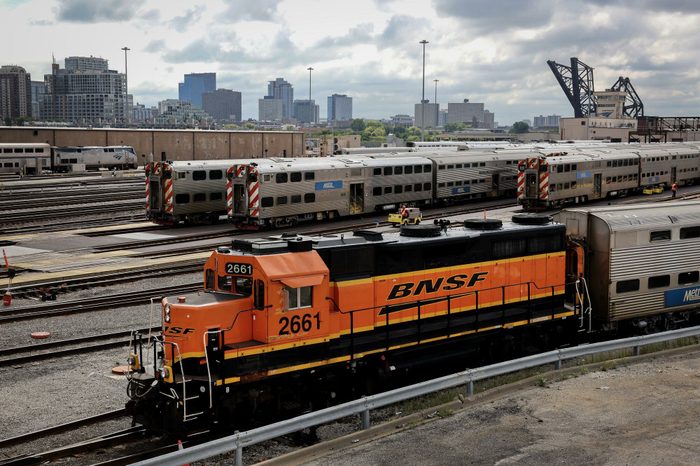
Payback Time?
Railroad workers tell In These Times that, since public land was awarded to the railroads in the first place, it shouldn’t be inconceivable for the public to take it back. “The American public should finally get a return on their investment,” Hugh Sawyer says. “The railroads were given quite a bit. We should get something in return.”
The government does have the power of eminent domain to seize property in the public interest, and that power is often invoked for the benefit of private companies — in building pipelines, for example. But even if successful, eminent domain would typically only apply to the land under the rails. By taking that land, the government would also be taking the tracks and other infrastructure, and the Constitution is clear that private property can’t be seized without compensation. If railroad companies were denied the right to keep profiting off their infrastructure, the rail assets would likely be deemed “stranded,” and the companies could demand compensation.
And the national rail system is so vast that the payment would almost certainly be astronomical.
This situation has played out in the electric utility sector, for example, when municipalities have tried to take public ownership of local electric systems. Such an endeavor failed in Boulder, Colo., when the utility Xcel Energy argued the town would owe it $200 million for its “stranded assets.” Advocates tried for a decade to take over their electrical infrastructure, but a 2020 legal settlement reestablished Xcel’s franchise.
The temporary seizure of private assets during emergency situations does have some precedent, including the nationalization periods during the world wars. Even then, it faces legal hurdles. President Harry Truman, for example, essentially took federal control of private infrastructure and operations when he briefly nationalized the steel industry in 1952 to avoid a steelworkers strike during the Korean War. The Wage Stabilization Board had already ordered a wage increase for steelworkers, but the steel companies refused to comply unless they were allowed to significantly raise prices, a demand Truman denied. The day before 600,000 steelworkers were set to strike, Truman invoked emergency powers to seize the industry and keep the mills running. The union supported the move, but the companies were outraged.
The case went to the U.S. Supreme Court, where the justices — including liberals appointed by Truman and Roosevelt — decided 6 – 3 in the 1952 Youngstown Sheet & Tube Co. v. Sawyer case that Truman’s takeover was illegal. The current conservative Supreme Court could rule similarly if nationalization of the rail industry were to face legal challenges.
There’s another way nationalization could move forward: the government could buy enough company stock to acquire a controlling interest.
During the 2007 – 2009 recession, the Obama administration dumped $80 billion into the auto industry to take a controlling interest in General Motors and Chrysler while ordering bankruptcy proceedings to restructure the companies. It also bailed out (and temporarily took control of) insurance giant American International Group (AIG) to the tune of $170 billion, which was also described as “nationalization,” though the administration garnered criticism for doing too little to rein in the industry. Outrage ensued when AIG then paid out hundreds of millions of dollars in management bonuses.
Whether it’s paying for stranded assets or buying up shares, any form of railroad nationalization would likely cost billions. But advocates note the federal government is able to find vast sums in emergencies, such as the pandemic or aid to Ukraine, not to mention a nearly $1 trillion military budget. Buying up railroad infrastructure may be the type of radical change that seems impossible — until it isn’t.
Global Examples
Nationalization is the norm for railroads in much of Europe, Asia and Latin America, though some countries have pushed for privatization.
The Canadian National Railway (CN) was publicly owned for almost 80 years before its privatization in 1995. Starting in the late 1990s, CN claimed substantial business in the United States by buying up smaller U.S. railroads. Its privatization was followed by its “Americanization,” including cost-cutting and harsher treatment of workers, as labor magazine Canadian Dimension describes.
In 1993, Britain’s national rail system was privatized with a vertical separation model. Safety appeared to suffer as multiple operators competed to ship on tracks owned by a separate company. Between 1997 and 2002, five horrific accidents left more than 50 people dead, with media coverage implying that privatization played a role. The company that owned the tracks went bankrupt and its infrastructure was renationalized, with most operations now run by private companies through government contracts. The U.K. continues to grapple with problems caused by the privatization effort, and a 2022 Survation poll found 68% of the public favors public ownership.
Germany began its railway privatization process in the early 1990s, cutting staff and routes for efficiency. But full privatization plans were scuttled by massive worker and public opposition and the effects of the 2007-2008 economic crisis. A government owned corporation still controls the system.
China, Russia, Ukraine and India similarly run their railroads through state-owned corporations, which are meant to be funded by their own revenue but not driven by the profit motive of a private company. China, however, is among multiple countries that have sought private investment in nationally run rail systems in recent years.
In Mexico in 1908, President Porfirio Díaz began nationalizing railroads owned by foreign investors. Perhaps ironically, the railroads played a key role in the Mexican Revolution that overthrew him, as campesinos and workers moved cheaply and easily around the country by rail, fueling popular struggle. The famous photograph of “Adelita,” a woman soldadera leaning from a train, became one of the revolution’s iconic symbols. Following the revolution, private and foreign investors regained ownership. Leftist President Lázaro Cárdenas renationalized the railroads in 1937, but in later decades they suffered disinvestment and mismanagement. In the 1990s, the railroads were again privatized and passenger service gutted.
Today, leftist Mexican President Andrés Manuel López Obrador is building a new, nationalized freight and passenger railroad across southern Mexico to spur economic development, but the multi-billion-dollar, nearly 1,000-mile Tren Maya has been criticized for building across fragile ecosystems, sacred Indigenous lands and ancient ruins.

Regulating and Reckoning
Another approach to nationalization might come through incremental railroad regulation. It could start by reviving (and augmenting) the regulatory powers held by the public in the early days of rail.
The 1876 Supreme Court case Munn v. Illinois upholds the government’s right to regulate private industry. The case involved allegations that a Chicago grain elevator company wasn’t fairly paying farmers for their harvests, and the Supreme Court affirmed the Illinois Constitution’s stipulation that the government could regulate railroads, warehouses and other entities for the common good, enshrining the concept of public utilities.
The 1854 Vermont Supreme Court case Thorpe v. Rutland & Burlington Railroad, regarding a sheep killed by a locomotive, determined the government could order private companies to do things for the public good that affect profit. Namely, the government could force railroads to install cattle guards at their crossings.
Railroad workers and experts alike say the four major carriers are failing to uphold one of the regulatory mandates that does still bind them: the “common carrier obligation” to provide “transportation or service on reasonable request.” Shippers argue that the major rail companies are effectively denying service to customers through their limited options for shipping, line abandonment and the railroads’ use of “embargoes” on certain shipments caused in part by worker shortages. Unlike electric utility and power companies (which go through lengthy regulatory proceedings to close power plants or develop transmission lines), railroads have few checks on such decisions.
“The fact that Biden was willing to break with the unions” shows that — as the Supreme Court found in Munn—the railroads are among industries “so critical we shouldn’t just leave them to the market,” says UCLA law professor William Boyd, who has written extensively on the challenges of regulating utilities and railroads. “The basic common carrier model should apply, to make sure you can’t discriminate against certain types of customers. It becomes a platform for everybody to compete with each other.”
Boyd says the current situation evokes “the same story we’ve heard since the beginning: ‘We [railroad companies] are standing here at the gateway of commerce and we should be able to charge any price we can.’”
Georgia College and State University adjunct professor Peter Moore formerly represented a dozen companies that owned 1,500 railroad cars carrying chemicals and other specialty products for freight railroads. He notes those companies, and the industry at large, have suffered as the major carriers restructure the pricing system to their own advantage, including eliminating a per diem paid to the owners of specialty cars.
“I use the term ‘oligarchy’ because there’s just a few [railroad companies] and they’re very powerful,” says Moore, who explored the concept of nationalizing railroads in a 2021 piece for the trade publication Supply Chain 24/7. “With a very limited number of competitors, a natural consequence is labor gets squeezed, customers get squeezed, governments get squeezed. There’s a natural tendency, when you have fewer and fewer companies — they get aggressive in the ways they handle the market.”
Moore doubts railroad nationalization is likely any time soon, but he thinks increased government regulation is crucial, including forcing the major railroads to allow more access to their tracks for competing railroad companies.
Some railroad workers are likewise skeptical that nationalization could work. “More stringent regulation is where we begin in my mind,” Matt Weaver says. “Public ownership is such a big thing and hard for the public to fathom.”
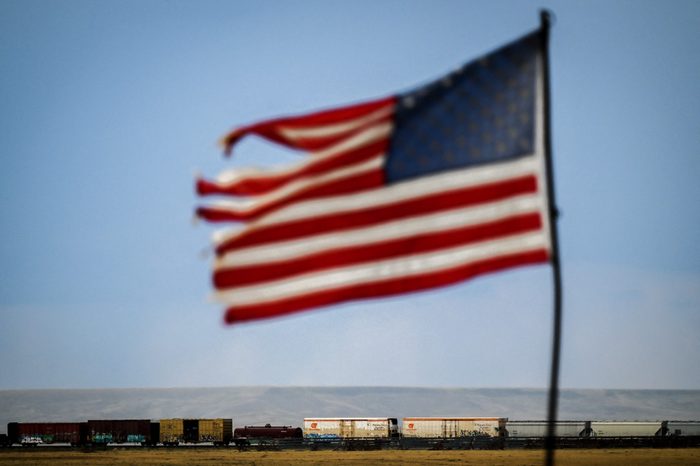
Ron Kaminkow is among the workers who prefer wholesale change — and now. “If the only choices are the status quo versus some form of regulation and restriction to rein the Class I carriers in, then I suppose I would support the latter,” Kaminkow says. “However, just like regulating the health insurance industry — providing Obamacare or what have you — these are not real solutions.
“We need a national healthcare system. I think the same thing holds true for the railroads.”
While there’s been little talk of outright nationalization among politicians, there is clearly recognition of just how desperately change is needed. At the Surface Transportation Board hearings in April 2022, Secretary of Transportation Pete Buttigieg said the board will require improvement plans from the railroad companies that include an examination of the impact on workers and the need for a larger workforce.
“When we overburden rail workers, it only furthers turnover, worsens service and presents serious safety issues,” Buttigieg said.
The major rail unions are currently organizing ahead of the next round of contract negotiations, which are set to start in under two years. Some, like the SMART Transportation Division, are calling on Biden to issue an executive order guaranteeing sick leave in the industry.
Kaminkow and others have vowed to keep building up the power and unity they’ve amassed this past year, and they hope nationalization will become central to the discussion. Railroad Workers United is planning to expand its campaign around nationalization, though the labor organization still only counts a small percentage of the total railroad workforce among its members.
“The discontent and the anger of the rank and file of all the crafts in freight service” are stronger than they’ve been in recent years, Kaminkow says. “Railroad workers finally see the game for what it is, and that their wages, benefits, working conditions and numbers of employment are going to continue to suffer as long as the railroads are held privately. There is no alternative but to consider nationalization and public ownership.”
Kari Lydersen is a Chicago-based journalist, author and assistant professor at Northwestern University, where she leads the investigative specialization at the Medill School of Journalism, Media, Integrated Marketing Communications. Her books include Mayor 1%: Rahm Emanuel and the Rise of Chicago’s 99%.
